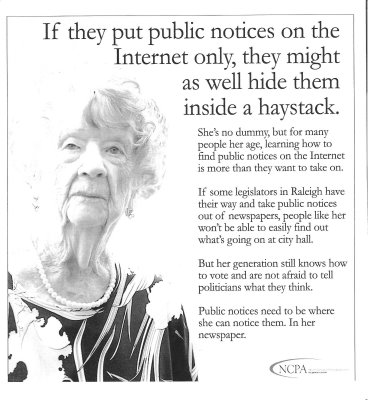 Vanity Fair uses a lot of words to describe Arthur Ochs Sulzberger Jr. in its 11,000-word profile of the New York Times Co. chairman, but “complex” isn’t one of them. That isn’t to say that Sulzberger isn’t bright. It’s just that he appears to be ill-suited to cope with business problems that are swamping executives with far more business savvy and seasoning.
Vanity Fair uses a lot of words to describe Arthur Ochs Sulzberger Jr. in its 11,000-word profile of the New York Times Co. chairman, but “complex” isn’t one of them. That isn’t to say that Sulzberger isn’t bright. It’s just that he appears to be ill-suited to cope with business problems that are swamping executives with far more business savvy and seasoning.
Mark Bowden’s profile is sympathetic, even moving in places, but it won’t put shareholders of the New York Times Co. at ease. Sulzberger, who is the fourth member of his family to run the company, is clearly a hard-working, well-meaning, engaging man. When he assumed stewardship of the company in the late 1990s, he saw his job as being to keep the ship on course. That worked well until tectonic shifts began reshaping the business began around 2001. Since then, we get the sense that Sulzberger has been way out of his league.
“The Sulzbergers embody one of the newsroom’s most cherished myths: Journalism sells,” Bowden writes. “But as a general principle, it simply isn’t true. Rather: Advertising sells, journalism costs.” The Sulzberger family has always operated on the principle that investing in a quality product will lead to business success, and Sulzberger has perpetuated that value in the face of recent overwhelming evidence to the contrary. Throughout his 20-year tenure at the Times, he has concentrated his investments in traditional media like the Boston Globe while demonstrating almost blithe ignorance of the changing publishing landscape.
Agnostic = Indifferent
Bowden homes in on Sulzberger’s famous quote that he is “platform agnostic.” Agnosticism implies lack of commitment, but it also reveals a basic misunderstanding of new media. “When the motion-picture camera was invented, many early filmmakers simply recorded stage plays, as if the camera’s value was just to preserve the theatrical performance and enlarge its audience,” Bowden writes. “The true pioneers realized that the camera was more revolutionary than that. It freed them from the confines of a theater.” So it is with newspapers today. The issue isn’t the platform, but rather the basic approach to news. The Times’ traditional top-down style is less and less meaningful to an audience that wants diversity and immediacy and online revenues simply won’t support a large, vertically integrated organization.
The Times Co. has made a few spot investments in Internet ventures like About.com and its website is arguably the best (and most well-trafficked) of any newspaper in the world. However, these times demand reinvention of the business and the Vanity Fair piece implies that Sulzberger is not the guy to do it. In contrast, it singles out Rupert Murdoch as the company’s most dangerous competitor and potential acquisitor.
Described as a “lightweight” and even “goofy” at one point, Sulzberger is clearly a nice and likable guy but not one given to tough decisions. He is a fan of pop psychology team-building exercises, even though they make his hard-bitten managers groan. And he is prone to risk avoidance. Bowden describes one management offsite exercise in which executives played a game that challenged them to decide between safe choices and higher risk but potentially more rewarding long shots. An employee who had witnessed many groups play the game observed, “This is the most conservative group I have ever seen.”
The Vanity Fair piece doesn’t attempt to cast any new light on the problems facing the newspaper industry; it’s a profile of the man who is perhaps under more pressure than anyone to come up with a solution. This is a complex profile of a man who doesn’t sound very complex. That can’t be good news for the Times.
Miscellany
The Associated Press, which has drawn much scorn from newspapers for its licensing terms, is cutting prices again. At its annual meeting in San Diego, the news cooperative announced $35 million in rate assessment reductions for 2010 on top of $30 million it made this year. The service also said members can now cancel their membership with one year’s notice instead of two. The AP also threatened to “pursue legal and legislative actions” against websites that don’t license news content and that it would track news distributed to members to see if it’s being misused. The AP may be in a better position than any of its member news outlets to actually enforce such a policy and it has the clout to put together a consortium of members to charge for news access if the law permits it.
The AP’s Canadian counterpart, called the Canadian Press, is laying off 25 people, or about 8% of its workforce. The service has been the victim of withdrawals by two of Canada’s largest publishers.
Newsosaur Alan Mutter is so fed up with people dancing on the graves of newspapers that he is banning newspaper-bashing comments from his blog. He can’t resist offering one last example, though.
The Milwaukee Journal-Sentinel laid off 26 full-time and five part-time employees and proposed a third round of buyouts aimed at cutting newsroom staff.
And Finally…
Is this how you’d like your typical reader portrayed? It’s an ad created by the North Carolina Press Association to urge citizens to fight legislation which would allow local governments to post public notices on the Web instead in local newspapers. We don’t know about you, but the ad seems to imply that newspaper readers are old and technophobic (courtesy McClatchy Watch).
Comments
This entry was posted on Tuesday, April 7th, 2009 at 7:35 am and is filed under Facebook. You can follow any responses to this entry through the RSS 2.0 feed. Both comments and pings are currently closed.




Let me be the first to say it: Advertising doesn’t sell. That’s a part of marketing’s job.
Advertising costs, journalism costs. Paper costs. Printing costs. Delivery costs. Everything costs.
Driving those costs down makes the difference between thriving and bankruptcy.
The bald fact is that using the internet and the latest incarnation of the web (call it Web 2.5,) is profitable enough.
Its not perfect. Not by a long shot. But its profitable enough. So your company grows more slowly (and even that is debatable given the reach of the internet,) but its growing, and growing at a pace you as a manufacturer of stuff can control and afford.
And all the rest is less profitable so its all dying in the harsh light of this economy.
And finally…
The “image” of the older citizen as someone who is disconnected from everything is wishful thinking on the part of the politicians, politico’s and control freaks, the old guard.
Check your demographics on broadband adoption.
If it wasn’t for the web, I’d never have seen this ad.
The agency was hoping it was stuffed under a haystack somewhere in North Carolina.
Two of the biggest money makers left at newspapers today are obits and legal notices. If newspapers lose the legal notices, look out.
We all know a substantial percentage of readers are elderly and can’t find their way around the Net. It’s a legitimate argument.